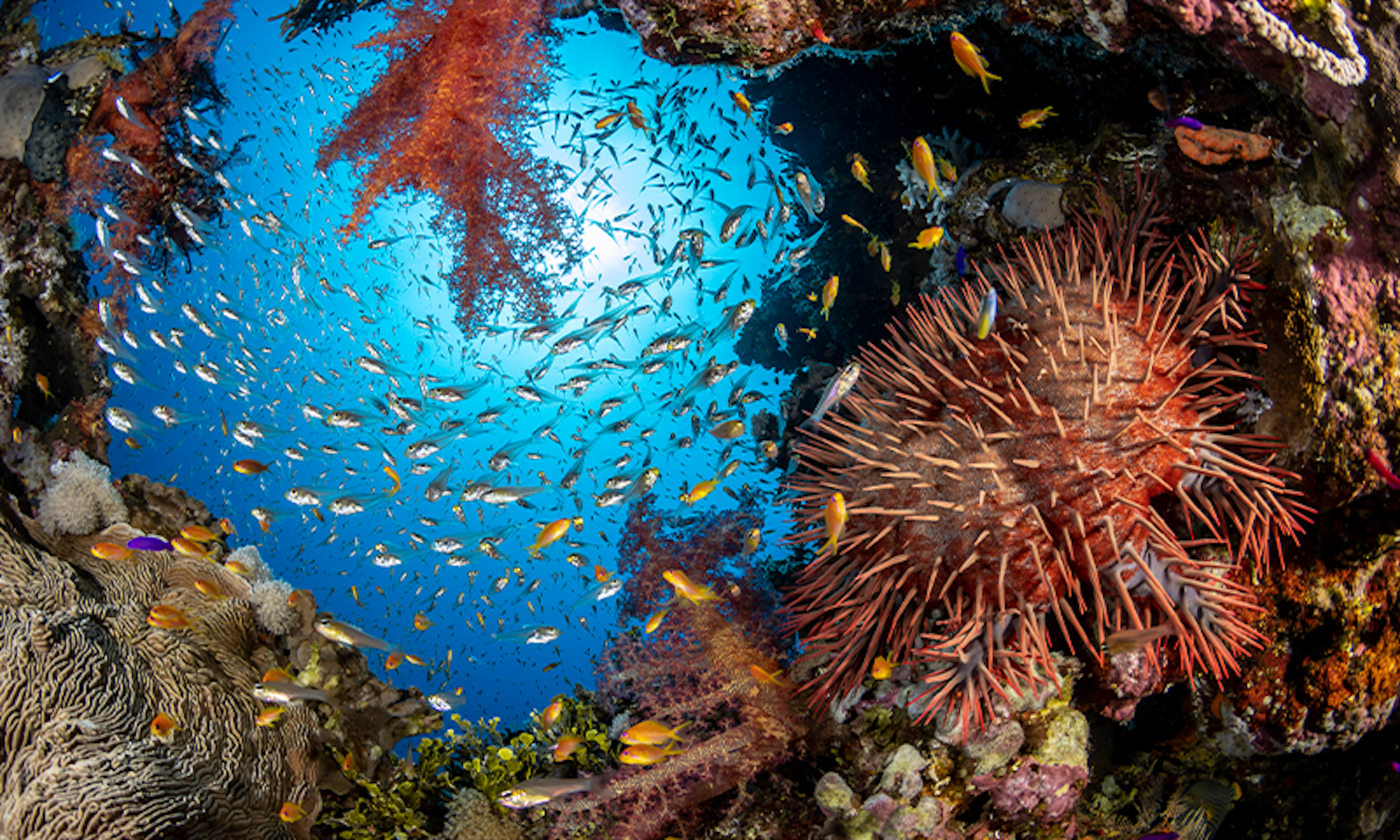In 2016, a small group of coral scientists gathered at a workshop in Florida to discuss the future of Earth’s reefs. The prognosis was grim and the future uncertain, but they knew one thing for sure: Conservation was no longer enough.
Just a few decades earlier, episodes of bleaching—when heat-stressed corals eject the colorful algae with whom they live in symbiosis, leaving their whitened bodies weakened and starving—had been almost unknown. Now, with ocean surface temperatures rising by nearly one degree Fahrenheit since 1980,1 they were common.
Nearly half of Earth’s corals have already succumbed. Without dramatic changes to current carbon emission rates, only 1 percent of corals are expected to survive by 2050. And while protecting reefs from pollution, illegal fishing, and development—the core of coral conservation—remains important, it had become clear those steps were inadequate to the existential threat posed by warming.
Because of fear of unintended consequences, they’re literally letting the reefs around them die.
The scientists at the Florida workshop had not gathered to bemoan the future, though. They came together to ask: What can we do about it? “The best analogy was the moonshot stuff—the Apollo space programs,” says Tom Moore, formerly the head of coral restoration at the National Oceanic and Atmospheric Administration (NOAA). “It was, ‘We don’t know how to get there. But we’ve set the goal, and we’re going to go there.’ ”
The workshop spawned the Coral Restoration Consortium (CRC) with Moore as its chair. Their mission: to understand what works, what doesn’t work, and what innovations are needed to restore ailing coral reefs to health. In 2018, CRC hosted Reef Futures, their inaugural international meeting. Four hundred coral restoration practitioners gathered to compare notes. When they met again in September 2022, the number of people attending blossomed to 600, hailing from 50 countries. The future of coral reefs—and the one-quarter of all marine species that they support, supplying protein for up to 1 billion people and providing $2.7 trillion in economic value every year—might still be in doubt, but scientists are meeting it head-on.
Moore recently left his position at NOAA to direct an ambitious 100-hectare restoration project in Saudi Arabia’s Red Sea. It is the largest such effort to date. “We’ve got the resources,” said Moore, who sat down with Nautilus to talk about innovations in the field, challenges that remain, and what the advent of large-scale restorations like the Red Sea project portend. “Now we just have to figure out how to do it.”
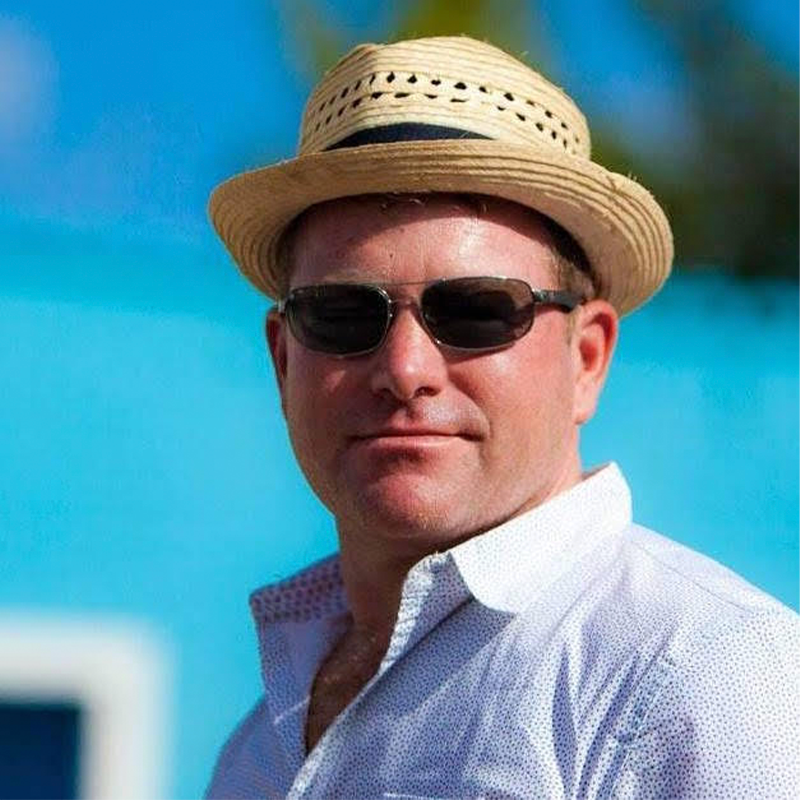
Four years ago, when I heard you talk about innovating around coral reef restoration, you kept saying that “we need crazy ideas.” Do you feel like those crazy ideas have been thought up yet? Or do you think we’re still searching?
The bar has been set even higher than I ever anticipated. In 2018, I expected that we would never convince people to make big investments in coral restoration until we could show that we could get to scale, that we had the tools and developed the technologies.
What’s actually happened is that coral restoration as a concept has caught on so much more that we didn’t necessarily get all the tools developed. We don’t necessarily have all the crazy ideas—but we have really crazy ambition. And now that ambition is driving the tool development.
By big investments, are you talking about the Global Fund for Coral Reefs?
That would be one, but that’s actually not what I’m thinking of. I’m thinking about projects like the one I’m leading here. I’m thinking of a number of other big efforts in the Middle East that I’m not in the position to discuss just yet. There are deep pockets coming and saying, “We want to be at the forefront of coral restoration. We want to do big ambitious things. Here’s the resources, go do them.”
We’re left going, “Okay, well, how do we work at scale?” We knew how to do things at relatively small scale. We talked about needing to figure them out on a big scale—and next thing you know, people are like, “We believe in you. Go ahead and do it.” Nascent ideas are now actually being thought through in the context of real projects.
One of the challenges that I’ve seen is that somebody comes up with a new idea—say, for 3-D-printing an artificial reef, or a new substrate they think is going to work. There are a lot of people with crazy ideas out there that have potential merit. But for those to become reality, they have to get connected to reality. That has been the disconnect.
What are the nuts and bolts of coral restoration? And what are the technical challenges that still need to be developed to get to a bigger scale?
Corals naturally reproduce in two ways. One is asexually, through breaking individual fragments into numerous individuals. So you can take an individual coral the size of your hand, break that up into maybe 50 smaller individuals that are genetic clones of each other, and grow them. A year later, you can break each of those up into another 50 individuals. You exponentially increase them. That is the predominant approach used in restoration so far.
The other way corals reproduce is sexually, where eggs and sperm are released from an individual colony to float in the water column. They cross with eggs and sperm released from other colonies. A very small portion fertilize each other and create a larva that eventually finds a spot on the reef. In restoration, we take corals in the wild and capture the eggs and sperm—or, more commonly now, actively cross-fertilize corals in the lab. We create larvae that settle onto substrates and eventually those substrates are planted in the wild.
What we have to do now is figure out how to shift restoration to be more along the lines of agriculture. The best analogy is a community garden: That is the scale of what restoration has been to date. And there is always going to be a place for the community-driven model. That’s critically important for getting things started in communities and keeping them rooted there—but we have to move toward more of an industrial, commercial model for those large-scale projects.
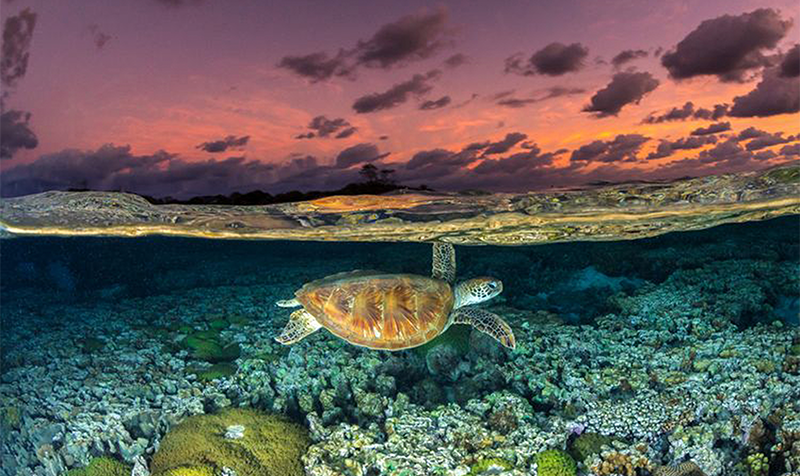
Some people have voiced concern about whether corals planted in restoration projects contain enough genetic diversity, or that selecting for tolerance to extreme heat could come at the expense of other important traits. Is that an issue?
Selection for particular things today inherently puts you in a position where you might not be selecting for things that are important tomorrow. Stony coral tissue loss disease in the Caribbean was not anticipated 10 years ago. Then, all of a sudden, it was an issue. Who knows what’s going to pop up 25 years from now in a particular place?
That said, I think there’s a balance to be struck. Projects should incorporate both asexual and sexual approaches. Any asexual approach is going involve some selection, whether it’s selection for what grows better in a particular environment, or for heat tolerance, or any number of other practical reasons. If you balance that with sexual reproduction where you’re focused on diversity, I think that’s important as well.
We are going to lose, and already have lost, large swaths of our coral reefs.
We have to be pragmatic about this in our decision-making. We spend a lot of time worrying about unintended consequences. But if you look at the data—just search for a paper called “Intended Consequences,” by the conservation group Revive & Restore—it suggests that the vast majority of conservation decisions and conservation biology decisions have gone right.1
I see managers in many places trying to be so prescriptive in their approach, because of fear of unintended consequences, that they’re literally letting the reefs around them die. This is a big issue in Florida right now. Regulators are so worried about introducing corals or moving them around. At the same time, they’re not paying attention to the fact that the reef is dying. There’s not much left. The state is just unwilling to take action because they’re scared.
You recently moved from NOAA to the King Abdullah University of Science and Technology to oversee one of the largest coral restoration projects to date. Can you tell me a little bit more about why you made the move?
I have been talking at NOAA and in the Coral Restoration Consortium for a number of years about the need to make big investments in concentrated places and to demonstrate that we could do work at scale. I really wanted to work on the kind of project where we could say: If we were starting from scratch, how would we do this in a particular place? How would we build this for scale? This provided that opportunity, and those don’t come around very often.
One of the best-known recent restoration campaigns involves coastal mangrove forests. There turned out to be a lot of problems, and one of the lessons was that perverse incentives resulted in failures. Money was on the table; targets were set; there was an incentive to do something, even if it wasn’t necessarily the right thing—like planting trees where they didn’t belong, or using the wrong species, or planting trees when natural regeneration would have been better. Is there a fear of similar traps that coral restoration could fall into?
There’s no question that we as a field are going to find ourselves in that trap. But I think it’s an inevitable growth phase. The reality is that philanthropic resources to do good in the perfectly right places often don’t exist. There are strings attached all the time. And I think that happened with mangrove restoration. The same thing’s going to happen with coral restoration. That’s the reality.
But if you want real money to do real serious work—especially when it hasn’t been proven at scale before—you have to be willing to go to the money to some degree. In some cases, those are investments that might be for tourism benefit. They might be for protection of a particular community from a coastal defense standpoint. They might be for the ability to say, “We’re proud of what we did in our particular place.” That sometimes pulls you away from the most ideal location. However, I think it’s important to think about it in the right context: What’s really important is that you use those as demonstrations. You use those as opportunities to try different approaches.
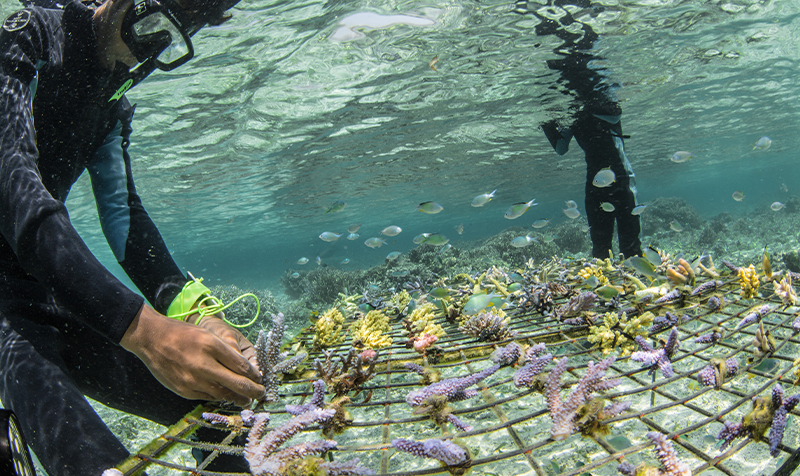
Mangroves and seagrass beds have both been identified as critical ecosystems for carbon storage. Is it appropriate to talk about carbon storage for coral reefs, too?
For coral reefs by themselves, you can’t make the math work on carbon sequestration. However, if you zoom out to the ecosystem level, which includes mangroves and seagrass beds, they all have synergistic effects on each other. They all help each other thrive; their demise helps each other fail. But certainly, if we’re talking about straight credits, mangroves or seagrass beds do a better job of sequestering carbon. That said, it can be a slippery slope with carbon credits. We’ve already seen in the carbon credit market a lot of less-than-perfect projects.
I’m not out there advocating that coral projects should be considered for carbon sequestration credits. I do think, though, that biodiversity credits could be a really important part of future funding.
I also think we have to accept that we cannot restore our way out of the coral reef crisis. We are going to lose, and already have lost, large swaths of our coral reefs. But what we can do is protect certain places. And we can double down on investments in areas that we expect to be resilient long term.
One of the most important messages ever given to me came before we were even seriously talking to coral restoration. We spoke to folks in the Smithsonian Institution who had experience bringing back other species from the brink. Their argument was, “Don’t put yourself in the position we’re in with rhinos or pandas or any number of these other iconic species that we got down to tens or hundreds of individuals. You have a huge opportunity to get in front of this problem, to at least maintain enough genetic diversity that the system can eventually recover itself.”
We’re never going to restore our way out of this problem. What we can do is maintain certain places and the resilience of those places. They can be islands that eventually help the system recover.
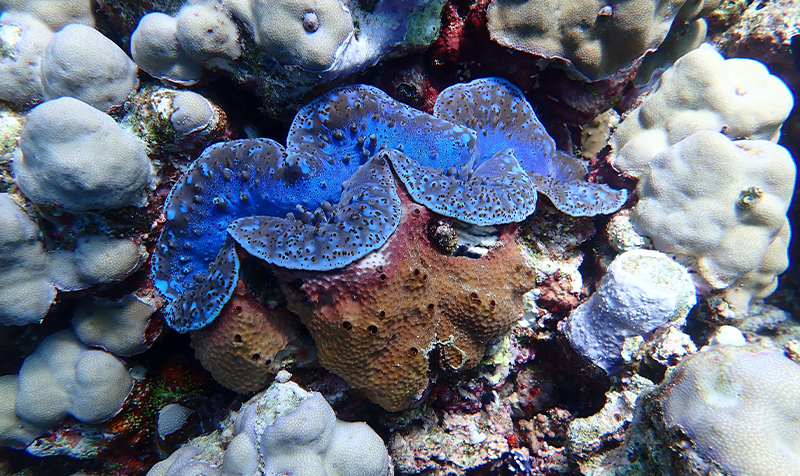
If you compare coral reef restoration to land-based restoration, the technical challenges are much harder in the coral world, and so the speed is necessarily slower. Do you think that could be a benefit in that some of the other pitfalls that other restoration projects have fallen into might be avoided?
At the recent Reef Futures meeting, one of our keynote speakers from Indonesia talked about the pitfalls of things that are called “restoration” there. And it was jaw-dropping to people in the room. There were audible gasps about things being called restoration that, to many of us, would be the opposite of restoration. Some of those pictures were of people putting structures on top of existing, very healthy coral reef, supposedly as a way to restore it. Or of people disposing of tires or cars or other junk on a reef and calling it restoration—when in reality, they’re just disposing of things they don’t want on the surface. It’s really important to get this information out there.
One of my biggest fears about this field going forward is that the more success restoration has, the more we legitimize reef destruction. This is exactly what happened with mangroves and seagrasses. The second we figured out how to restore mangroves and seagrasses and salt marshes, it became okay to destroy seagrasses and salt marshes in some places because we could fix them and we could restore them in other places.
If you talk to the old-school scientists about their reservations around restoration, they’ll tell you their reservations are around the feasibility of restoration at scale—which I think we’re going to prove them wrong on. But my big fears are legitimizing reef destruction and making an excuse to not deal with climate change. The other fear is that everything out there starts to get called restoration when it’s not.
When we talk about reef restoration, we don’t talk about just large spatial scales, but temporal scales as well. So how do we plan for long-term security of coral?
There’s talk about coral banks and gene banks in the same way we have seed banks. Hopefully we won’t ever need them—but if future generations do, they’ll be glad we built them. That, however, is the cataclysmic scenario. To really be at a point where we’re trying to pull corals out of a bank means we didn’t follow the advice I talked about earlier: Don’t get yourself into that problem in the first place.
If we can keep enough reefs stable through a combination of conservation and restoration and picking smart places to work, then that allows those places to be banks themselves. That’s a much more practical solution than physical, locked-down banks. Because if we’re at that point, the problem is really bad, and we’ve really lost it.
The flip side of that question is that we often delay taking action because we’re afraid of how long it will take, or that it will be complicated, or that we won’t be able to reach scale. And so we spin on those issues and don’t take action. The reality is, I don’t know exactly how long it’s going to take to restore what we need to restore. I don’t even know what we need to restore. But I know that if we don’t start today, we’re never going to figure out the technology that we need to do it tomorrow.
We can’t restore our way out of this problem—but we also can’t wait to start because we’re waiting for that perfect plan or that perfect scenario. I don’t know exactly what’s going to happen with coral restoration over time, but I know that if we don’t get started and figure it out, then in 10 or 15 years we won’t be in any better position than we are today. We’re going to be sitting there saying, “It’s going to take a long time.” ![]()
Lead image: Renata Romeo / Ocean Image Bank
References
1. Phelan, R., Kareiva, P., Marvier, M., Robbins, P., & Weber, M. Why intended consequences? Conservation Science and Practice 3 (2021).















